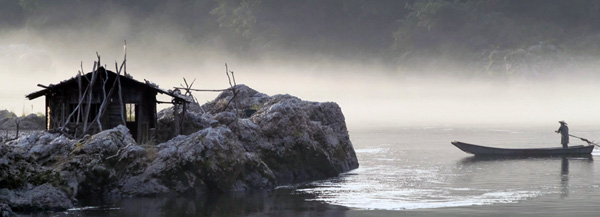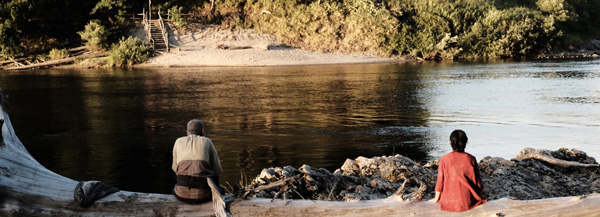
‘They Say Nothing Stays the Same’ is the second film that Japan’s Joe Odagiri, best known as an actor, has directed, 10 years after his first film ‘Looking for Cherry Blossoms’. This second project has already received recognition at several international film festivals.
The film’s colourist is Soichi Satake from Toei Digital Lab in Tokyo. Soichi joined the company in 2005, where he had the opportunity to learn his trade as the Japanese film industry was shifting its workflow towards digital intermediate. Although he has an established career behind him, this project is the first time he has been involved with a project from such an early stage, working on-site during the shoot and through to final colour.
At the pre-production phase, the producer Takuro Nagai looked for a colourist who spoke both English and Japanese so that the production team could hold colour grading sessions without a translator. Not many colourists in Japan speak English, but Soichi has had previous experience conducting colour grading sessions with clients overseas, which attracted the filmmakers to Toei Digital Lab. The facility has six Baselight grading systems and a FLUX Store system, all connected via a cloud network to share projects.
Soichi said, “As a DI facility, it is important to create an environment without language barriers so that everyone – the DoP, the Director, the producers and so on – can concentrate on the project. Director Joe Odagiri also speaks English, so the entire session was in English.
Show Your Stuff
Working with Australian-Hong Kong DoP Christopher Doyle was another new experience for Soichi. “The first thing Chris-san told me was ‘Forget about the dailies look and show me your stuff.’ This was encouraging and quite an unusual request from a cinematographer – at least in Japan. That meant I could bring my own creativity and personal ideas to the project.

“I visited the shooting location, a rural area in Nigata, while the movie was in production. I had never been there before and even didn’t know that this place existed. It was so beautiful and untouched – I was really surprised to discover such authenticity left in the heart of Japan. Combined with my early involvement in the production, it made me feel even more excited to grade the film.”
While on-set, he could join discussions with the director and DP and share their thoughts during the production phase, a unique experience for him because he is usually limited to feedback and ideas he receives afterwards. Therefore, he had quite a good understanding of the way they wanted to tell the story. For example, the focus shifted to a love story as the shoot progressed from day to day.
“This helped me develop the initial look. Chris-san referred to older classic Japanese films from the 1960s and ‘70s. Toei’s historical films from this period had certain contrast characteristics and deep green foliage, so I used them as my main references. Baselight's Texture and Shader tools, and built-in Add Grain tool, which has several different parameters to tweak, were especially useful to create this kind of look and feel.”
Texture and Detail
The Baselight Texture Equaliser manipulates textures by dividing the image into spatial frequency bands, which can then be adjusted individually for precise control – allowing the colourist to smooth certain tones, for example, while preserving the texture and detail. This functionality made the tool useful for reducing the digital enhancements of modern digital cameras. Each band also has a separate Texture Blend control that creates a smooth join between two images that have sharp-edged mattes.

Add Grain was then applied across the entire film. Colour Cross-talk helped him tweak certain colours, using Paint not only for removing or erasing operations but also for creating masks.
“I was using Base Grade for the initial balance on every shot. In my opinion, it gives a natural feel for exposure and colour balance.” Exposure values and pivot points are specified in aperture stops, a familiar unit that matches human perception instead of relying on a video signal or film stock as a base. Base Grade has four parameters to affect the whole image – Flare, Balance, Contrast and Saturation – and then partitions the image into brightness zones.
Contrasting Colour
The director wanted to use contrasting colours to support the narrative. Soichi said, “Red is the most important colour in this film, and we talked about it a lot during our sessions. During the summer scenes, the colour green of the trees and the blue for the sky represent nature and people’s life in the countryside, where life and mood seem timeless. In opposition, the mysterious girl in a red costume, along with the red brick bridge, both symbolise alien elements in such a monotonous routine.
“In the winter scene, everything was covered in snow so the red stands out even more with fire and blood. All of the elements in red push the story forward. Therefore, I paid a lot of attention to the colour balance and saturation level of red and its counter-colour, while at the same time creating the feel of an old Japanese film.”

For the ghost scene, the production aimed to create an ambiguous atmosphere, between illusion and actually seeing a ghost. Soichi used Chroma Warp in the Shader operator around the ghost silhouette to help give it the feel of an illusion. “For this scene, it was important to highlight blood and fire combined, so I used the Hue Angle and DKey isolation tools in Baselight to achieve that, as well as shapes,” he said.
Final Effects
FilmLight Baselight’s Hue Angle keyer is a Hue, Saturation, Lightness (HSL) keyer, and displays a hue-wheel interface for visually adjusting hue and saturation, simultaneously. DKey is a 3-dimensional keyer that extracts out regions of the 3D RGB colour space in order to create a custom matte for secondary work. The user drags a bounding box over the image to sample and isolate the most useful range of colour, and once a matte has been created, he can switch back to the grading tools and make adjustments.
“Only limited shots and the CGI shots were sent to the VFX department, which meant quite a bit of the compositing work to remove elements had to be done directly in Baselight,” said Soichi. “As we were on a tight schedule, I had to do this work at the same time as the colour grading sessions but I didn’t want to spend too much time erasing things in front of the DoP and director. It was tough. I used Baselight’s vector Paint operator, which has Colour, Clone and Matte brushes and fully trackable paint layers, and managed to get it done on time.” www.filmlight.ltd.uk



